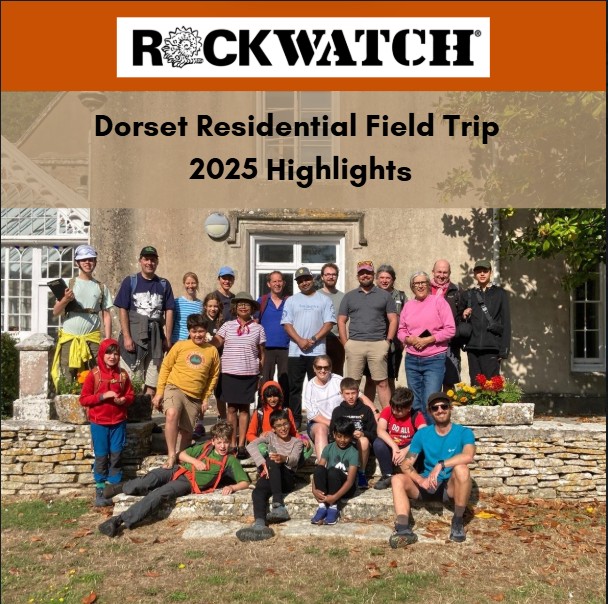This year’s annual Rockwatch residential trip to Dorset was another action-packed adventure! Rockwatchers spent five days based at our home for the week – the Leeson House Field Studies Centre, exploring some of Dorset’s most spectacular geological sites and making plenty of memories along the way.
Day 1 – Settling In
Rockwatchers arrived at Leeson House in the afternoon, filled with anticipation about the week ahead. The first evening was all about getting to know each other and enjoying games and activities around the centre before tucking into a hearty dinner and preparing for the first full day of geological fun.
Day 2 – Lulworth Cove, Mupe Bay & The Fossil Forest
Led by the brilliant Barry Cullimore, the group headed out to some of Dorset’s most famous geological landmarks, including Lulworth Cove, Mupe Bay, Bacon Hole and The Fossil Forest.
Barry showed how geology, wildlife, and landscapes are all closely interconnected. Rockwatchers discovered how butterflies and glow-worms can reveal secrets about the rocks beneath our feet and explored key themes such as paleo-environments, tectonics, and climate change.
A scramble across beach boulders took the group to Bacon Hole, known for its dramatic sea stacks shaped by erosion, and the intriguing Smugglers’ Cave – just the right size for our explorers!
Day 3 – Ringstead Bay & Kimmeridge
On Wednesday, Phil Vixseboxse guided us through two Jurassic hotspots: Ringstead Bay and Kimmeridge.
At Ringstead, Rockwatchers found a fantastic variety of fossils, including gastropods, brachiopods, and the impressive oyster Deltoideum delta. Although hammering is not permitted at this protected site, the beach was rich with finds.
Kimmeridge Bay offered more geological treasures. Famous for yielding more reptile remains than any other Kimmeridge Clay site in the UK, it’s also home to superb ammonites. While no collecting is allowed without special permission, we studied the rocks and learned about the Milankovitch cycles – the Earth’s orbital changes that shaped climate and sedimentation in the Jurassic seas.
Day 4 – Lyme Regis & Black Ven
Richard Edmonds took us to Lyme Regis; a town built on unstable shales and clays that are constantly shifting. Rockwatchers learned about the engineering needed to stabilise the cliffs and the wider impact of rising sea levels worldwide.
We visited the Mary Anning statue and heard stories of her remarkable, but challenging, life before heading down to Black Ven beach. Here, careful fossil hunting paid off, with many Rockwatchers discovering ammonites and belemnites – a perfect way to connect with Dorset’s fossil heritage.
Day 5 – Dancing Ledge
On the final morning, we walked out to the beautiful Dancing Ledge, a Portland Stone platform complete with a sea-filled swimming pool. With its giant ammonites, fascinating quarrying history, and its reputation as a haunt for smugglers, the site provided a wonderful end to our trip. The ledge lived up to its name too, as the waves made it appear to “dance” in the sunshine.
A Huge Thank You
We’d like to give a big Rockwatch thank you to the team at Leeson House and to our fantastic leaders Barry, Phil, and Richard, who shared their knowledge and enthusiasm throughout the week.
Most of all, thank you to our brilliant Rockwatch families for joining us on this unforgettable adventure. We can’t wait to see you again next year for more fun, fossils, and geological discoveries!
Watch some of the Highlights from this year’s trip on our You Tube channel.

